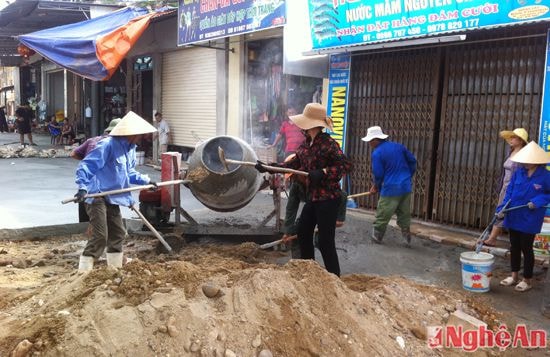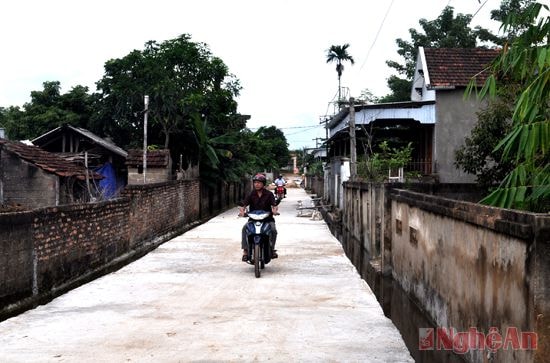Add more clean and beautiful rural roads
(Baonghean) - The rural traffic construction movement has been widely supported by people in all localities, who have contributed their efforts and money to turn narrow, muddy dirt roads into spacious, clean concrete village roads and alleys. That has contributed positively to improving the quality of life for people in rural areas.
Closed traffic system with concrete roads
The roads in the central area of Nghia Hong commune (Nghia Dan) are now solidly and spaciously concreted, built by the efforts of the local people, eliminating the muddy and difficult-to-travel scene, the sticky red soil that sticks to the tires every time it rains like before. After 4 years of implementing the new rural construction (NTM), the commune has mobilized all its forces to build more than 17km of concrete roads in hamlets with a total contribution of nearly 7 billion VND from the people. Not only contributing working days and cash, many households also voluntarily donated land and dismantled fences so that the hamlet could build roads with the required width.
The family of Mrs. Nguyen Thi Thanh in Hong Tho hamlet is one of the households actively supporting the movement to build traffic roads. Both of them only have pensions, but when the hamlet mobilized people to contribute to build rural traffic roads, Mrs. Thanh's family was willing to contribute 10 million VND. Mrs. Thanh said that "building clean and beautiful traffic roads is for her family to benefit, travel easily, and make her hometown and village more beautiful". Along with Nghia Hong commune, the communes of Nghia Khanh, Nghia Tan, Nghia Phu, Nghia Son, Nghia Hoi, Nghia Hung... also compete to build new rural areas, focusing on building traffic roads. Up to now, the whole Nghia Dan district has built more than 181 km of new rural concrete roads, and maintained and repaired over 73 km.
 |
| Nghia Hong - Nghia Dan people build rural roads. |
 |
| Traffic routes in Nghia Hong commune. |
In Duong Dong hamlet, Dien Phong commune (Dien Chau), since the beginning of 2015, people have enthusiastically contributed money and labor, ready to participate in road construction regardless of the weather, rain or shine. The whole hamlet has 144 households, 586 people, people's lives mainly depend on agricultural production, some work in construction and work far away, so economic conditions are still difficult, but people are very supportive of the local policy of building new rural areas. Each person contributed 600,000 VND to build all the roads in the hamlet. People voluntarily cleared the land, donated land, and cut down old trees. Many households actively contributed, such as: Mr. Tran Ngoc Nhu, Mr. Tran Huy Cu's family contributed 10 million VND... With the great efforts of the people, up to now, Duong Dong hamlet has built nearly 1.5 km of rural concrete roads and is continuing to build about 700m more to complete the traffic system.
Mr. Chu Minh Quyen, a cadastral and construction officer of Dien Phong commune, said: Up to now, the commune has basically completed 19/19 NTM criteria, and the locality is completing procedures to prepare for recognition of the commune as meeting NTM standards. This result is the result of the efforts of the entire Party Committee, government and people of the whole commune to complete the criteria, in which the criteria for building rural roads has been actively responded by the people. In addition to the province's cement support, the commune supports 10 million VND/km, and the people of the whole commune contribute 6 billion VND. Up to now, the whole commune has built nearly 14 km of rural concrete roads.
| People in hamlet 10, Nam Cuong commune (Nam Dan) build rural roads. |
The movement to build roads has been strongly and widely responded by people in rural areas and has brought long-term effectiveness to the locality. The quality of the works is sustainable and meets requirements, the traffic infrastructure has been improved, creating momentum for socio-economic development. Up to now, the whole province has built and upgraded 3,365 km of rural roads of all kinds, with a total cost of more than 6,295 billion VND. Of which, 1,052 km of village and hamlet roads have been asphalted and concreted to meet standards; 1,241 km of village and hamlet roads have been hardened to meet standards; 811 km of alleys and hamlets have been cleaned and cleared of mud; 261 km of main roads in the fields have been hardened.
For the construction of rural roads under the cement support mechanism, by the end of June 2015, the Provincial People's Committee had assigned the target of supporting localities in 4 phases, including 423,508 tons of cement (including additional targets), equivalent to 2,272 km. By June 2015, the whole province had completed 1,589 km/2,272 km, reaching nearly 70% of the plan, equivalent to 308,568 tons of cement. The province's investment and support in cement sources has created a driving force to promote the movement of building rural roads in the whole province, contributing to changing the rural appearance in many rural areas.
Improve traffic in flooded areas
During the flood season, many roads in the communes of the 5 southern regions of Nam Dan district are often flooded and people have to use boats and canoes to travel. With the participation of people and businesses, the rural traffic and irrigation systems have been upgraded, concreted, and paved, thereby gradually overcoming the flooding situation during the flood season. One of the localities that has done well is Nam Cuong commune (Nam Dan). Mr. Nguyen Dinh Bien, Head of Hamlet 10, said: "The roads in the hamlet are low and many sections have not been hardened, so during the flood season, the water rises and floods the roads, causing difficulties for people. Therefore, the commune has mobilized people in the hamlet to build roads. To implement this policy, people donate land to build roads, contribute money for labor days to raise the roadbed. Currently, the roads in the hamlet have been widened, concreted firmly and will ensure more safety during the flood season."
Mr. Tran Trung Dung, the officer in charge of land administration and construction of Nam Cuong commune, said: "Along with strengthening propaganda and mobilization work, the commune has established 5 groups in 11 hamlets to support in building traffic roads, and at the same time issued mechanisms and policies to attract and encourage people in the hamlet, commune and children far from home to participate in building traffic roads. Any hamlet that builds 100m of traffic road that meets the commune's standards will receive 5 million VND in support, and all money raised from people in the commune will be prioritized for building rural traffic roads. Therefore, the roads are basically concreted, and from the beginning of 2015 until now, 122 households have donated land with an area of 1,440m2, creating favorable conditions for the commune to complete 37 roads with a total length of more than 5.7 km with a total cost of 3.1 billion VND, of which people contributed 1.3 billion VND and Tuan Loc enterprise donated 1,000 tons of cement. (equivalent to 1.5 billion VND). In the process of upgrading and expanding the commune road, attention is paid to raising the roadbed to avoid flooding.
To promote the movement of building roads, especially in areas flooded during the rainy season, in 2015, the province supported 15 billion VND (funding to support rural traffic construction according to Decision 05/2009 of the Provincial People's Committee). Localities have combined with other capital sources such as: people's contributions, settlement projects, Program 134 CP, 30a, new rural areas, WB, IBIC, NGO, Luxembourg... to invest in building rural roads. Quy Hop district was supported with 1.1 billion VND with priority given to building inter-commune roads Nghia Xuan - Van Loi. This is an area heavily affected by floods and traffic roads are often flooded, the district has chosen to build a cement concrete road (1,025m long), 6m wide roadbed, 3.5m wide cement concrete surface with a total investment of more than 2.5 billion VND.
Mr. Vi Thanh Tuong, Vice Chairman of the District People's Committee, said: "During the rainy season, some roads in the district are cut off due to flooding, greatly affecting traffic and people's lives. Therefore, in recent times, the district has always combined priority capital sources to invest in upgrading and repairing these roads, gradually completing them, creating convenience for people in remote communes in Van Loi, Ha Son, Bac Son, Nam Son, Chau Hong, Chau Tien... From the beginning of 2015 until now, with the support capital from the State, organizations, businesses and contributions from people, Quy Hop has built more than 40 km of concrete roads".
The rainy and stormy season is approaching, the issue of ensuring traffic safety in flooded areas is of concern to all levels and sectors. The Department of Transport regularly organizes inspection teams and directs localities to promptly handle roads that are often blocked by floods and landslides, such as at Khe Than on the road through Nghia Binh commune, Tan Ky district, when it rains and floods, landslides and flooding occur. Especially the road from Tan Ky town to the old Pha Sen, this is the intersection with 2 rural traffic routes with provincial road 544B that is often blocked by traffic when there is heavy rain... Roads that are often blocked by floods and landslides, and key points on the road in Tan Ky all have timely handling plans.
Mr. Tran Khac Xuan, Head of the Department of Rural Transport Infrastructure Management, Department of Transport said: “Due to climate change, flash floods have occurred in mountainous districts, causing great damage to the rural transport system. Through many investment sources from the State, Road Maintenance Fund, community, enterprises... currently, roads that often experience landslides, flooding, or vulnerable points are being handled by functional units and localities, in order to ensure traffic safety during the rainy and stormy season.
Although the development of the rural transport system has achieved positive results, due to the total number of kilometers of roads (district, commune, hamlet, and village roads) being more than 20,126 km long, while the investment capital for maintenance and repair is limited, the rural transport network has not yet met the travel needs of the people. Currently, only 62.19% of district roads have been asphalted or concreted, 54.15% of commune roads and 44.47% of village and hamlet roads have been hardened. Therefore, in the coming time, the construction of the rural transport system is still a priority for the local authorities and people, creating a driving force for socio-economic development.
Quynh Lan - Hoang Vinh






